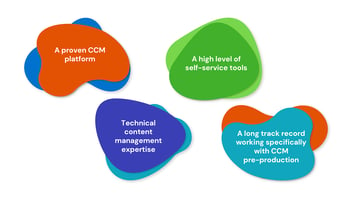CCM Output Management Services
Companies of all sizes, across all industries, can benefit enormously from a top-tier CCM strategy. Businesses want to interface with their customers efficiently, remain compliant with ever-changing government regulations, and make sure their customer’s sensitive data remains secure. More than that, they want to foster loyalty—the lifeblood of any business. Those that treat and speak to their customers with the upmost care are proven to not only retain numbers, but potentially turn those customers into outspoken advocates. Having a successful CCM strategy that fulfills these goals and more speaks for itself.
Managing communications with your customers can seem from the outset like a relatively easy process; many companies, especially small- or medium-sized companies, choose to internally source their communication enterprises. However, in this article, we’ll take a look at three key reasons why more internal print production operations (often referred to as "in-plant") are instead partnering with external output management service providers.

1. CCM Trends and Their Effect on the In-Plant Approach
As in any industry, moments arrive when current trends are powerful and complicated enough that companies begin to re-think their basic operating strategies and look at external providers. Here are just a few of these recent trends:- The multi-channel to an omni-channel transition: Fifteen years ago, the delivery channels print & mail, email, and SMS text were individually managed, often with separate data, design, and output teams. With the emergence of more sophisticated page composition engines, however, it became possible to manage them from a single compositional source. This "omni-channel" evolution helped move industries and customers alike into a new digital experience and has become the undisputed best practice in CCM production.
- The increasing regulatory oversights: With the continued rise of regulatory supervision, particularly from federal agencies, two topics have gained prominence:
- Business continuity: a common deadline for print & mail production is between 24 and 48 hours after the input file is available; this tight timeline for a financial department to deliver invoices is often a dictate from a federal agency or an internal policy. The deadline isn’t waived when an unexpected event slows or shuts down production, like a weather event or a workforce issue.
- 100% fulfillment and verification: many regulatory agencies not only require CCM programs to follow their policies, but to prove they did. The means to do so involve coding unique identifiers into mail piece barcodes, setting up digital cameras at printers and inserters to scan the barcodes, managing a database that stores and organizes the scanning data, and installing applications to report on it. The system must also accommodate mail pieces that were damaged during production and needed to be re-worked to achieve 100% fulfillment.
- The rise of diversity expectations: In the past five years, there has been a heightened awareness—and corresponding corporate commitment—concerning diversity as well as people with disabilities. This awareness, championed by the Americans with Disabilities Act, extends not only to corporate consumers but to their workers as well, creating demand for language translation services, culturally aware content, and ADA-compliant formats—braille, large format print, accessible PDFs, etc.
- The prevalence of the CCM platform: The digital transformation of the CCM industry has placed considerable pressure on the pre-production steps of data processing, page composition, and output files. This comes from dealing with more types of data input, managing complex omni-channel output, and responding to even greater scrutiny around tight delivery deadlines. Consequently, a CCM platform has gone from a "nice to have" to a "need to have.
For in-plant operations that have been focused solely on traditional manufacturing methods for years, integrating these new developments has become more than many can chew. The consumer’s growing preference for electronic delivery instead of print & mail has led many in-plant companies to question whether to continue allocating capital and labor to print manufacturing. But the switch to the omni-channel model is challenging, as often the electronic channels are handled elsewhere, even perhaps by an external provider.
Consequently, an enterprise CCM program needs a tested business continuity plan to invoke when interruptions inevitably occur. Government regulations and diversity expectations add yet another layer to this already complicated system, and as other businesses rise to the challenge and update their services, customers anticipate higher and higher standards as time goes on. These emerging trends are a costly headache and a logistical nightmare for internal operations.
The only way to meet the challenge with flying colors is to have a top-tier platform solution managing production workflow and ongoing developments. Equipped to manage all delivery channels, a top-tier CCM output service provider can fully integrate an omni-channel approach to optimize benefits and efficiencies. The best service platforms can also streamline all pre-production requirements, as well as production and post-production requirements, at minimal cost.
Rather than developing or investing in a platform independently, in-plant programs are moving production to CCM providers who have a platform already integrated with their production workflow and who can spread the expense of financing these systems across many companies.
2. The CCM Production World Post-COVID
The COVID-19 pandemic, as we all know, disrupted the world well beyond health issues: nearly all American businesses and their workforces were affected in one way or another. Although the pandemic has somewhat subsided, many of the changes that rocked the world then remain a permanent part of the economic calculus.
- Supply chain: Until COVID, this topic wasn’t much of a consideration. It is now. The availability of commodities, like paper, and their fluctuating cost can be quite a nuisance. It can be an even greater trial for single companies, who must navigate the procurement process alone. Leaving this challenge to a partner able to rationalize the process and leverage buying power to stabilize inventory and cost can be an incredible boon for many companies.
- Worker recruitment, training, and retention: COVID introduced many worker-related issues never seen before in American business, giving momentum to complaints concerning remote-work options and wage stagnation amidst rising expectations. When companies did not adapt to these issues, a significant number of workers resigned due to their overall dissatisfaction in what is now known as the Great Resignation. It touched every rung on the position ladder, from middle managers and supervisors to production workers. The work-from-home model has now stabilized as a hybrid approach with the in-office model, but recruiting and retaining workers remains an unprecedented challenge. A CCM service provider who has professional human resource staff dedicated to the task, as well as contacts within the employment community, can constantly drive applicants to the company.
3. Benefits from What Others Have Learned and Use
As CCM production becomes even more complex—with more digital solutions, more government oversight, more consumer empowerment—it’s nearly impossible to learn about and absorb all the best practices entering the industry. A benefit of a CCM service provider is acquiring and benefiting from these best practices as they enter the fray. Working with a thought-leader and innovator in CCM industry, like Neps, grants you access to the industry trends you need to integrate into your standard services.
Conclusion
Many in-plant operations are looking externally for their production needs and for good reason: it solves many problems around investment, business continuity, platform solutions, and issues concerning diversity and disabilities. Many of these needs weren’t even on the radar when most in-plant operations began and thus require a helping hand to properly renovate.
The CCM service model will always be subject to the expectations of its consumers and the strength of its competition. Neps’ staff of solution architects, developers, communication experts, analysts, and service professionals can guide your business through these changes and tailor a solution to support your business communication needs.



